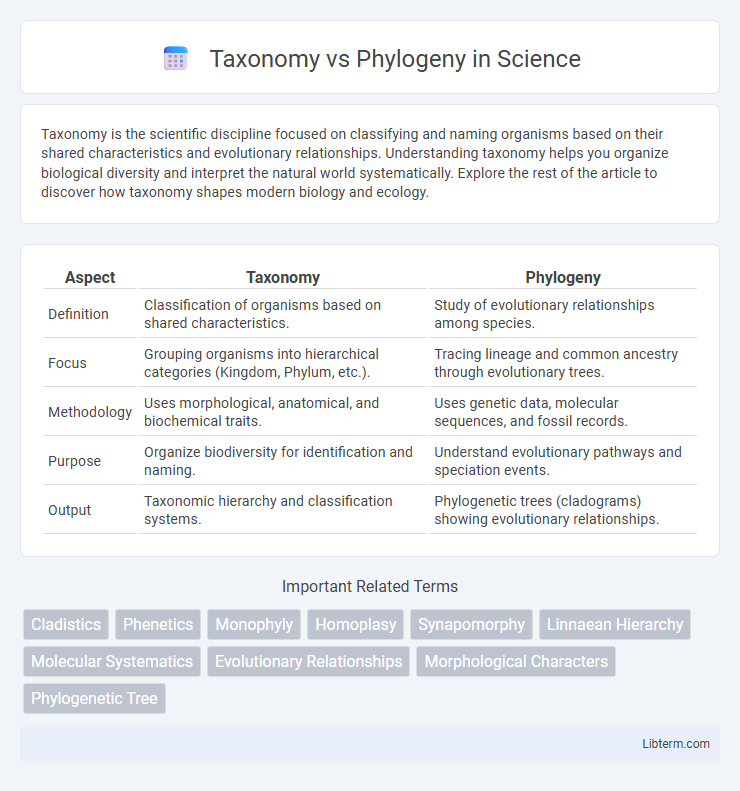Taxonomy is the scientific discipline focused on classifying and naming organisms based on their shared characteristics and evolutionary relationships. Understanding taxonomy helps you organize biological diversity and interpret the natural world systematically. Explore the rest of the article to discover how taxonomy shapes modern biology and ecology.
Table of Comparison
| Aspect | Taxonomy | Phylogeny |
|---|---|---|
| Definition | Classification of organisms based on shared characteristics. | Study of evolutionary relationships among species. |
| Focus | Grouping organisms into hierarchical categories (Kingdom, Phylum, etc.). | Tracing lineage and common ancestry through evolutionary trees. |
| Methodology | Uses morphological, anatomical, and biochemical traits. | Uses genetic data, molecular sequences, and fossil records. |
| Purpose | Organize biodiversity for identification and naming. | Understand evolutionary pathways and speciation events. |
| Output | Taxonomic hierarchy and classification systems. | Phylogenetic trees (cladograms) showing evolutionary relationships. |
Introduction to Taxonomy and Phylogeny
Taxonomy is the scientific discipline of classifying and naming organisms based on shared characteristics, establishing a hierarchical structure from domain to species. Phylogeny studies the evolutionary relationships among species, constructing phylogenetic trees that depict lineage divergence over time. Understanding the distinction between taxonomy and phylogeny is essential for interpreting biological diversity and evolutionary history accurately.
Defining Taxonomy: Concepts and Methods
Taxonomy involves the classification, naming, and identification of organisms based on shared characteristics and hierarchical categories such as kingdom, phylum, class, order, family, genus, and species. The methods in taxonomy include morphological analysis, molecular techniques like DNA sequencing, and computational tools to organize biological diversity systematically. This discipline provides a framework to describe biodiversity and enables comparisons among organisms by establishing standardized, universally accepted names and categories.
Understanding Phylogeny: Foundations and Approaches
Phylogeny explores the evolutionary relationships among species, providing a framework based on genetic, morphological, and molecular data to trace lineage divergence over time. It employs methods such as cladistics and molecular sequencing to construct phylogenetic trees that represent shared ancestry and evolutionary pathways. Understanding phylogeny facilitates insights into biodiversity, evolutionary biology, and the mechanisms driving speciation.
Historical Evolution of Taxonomic Systems
Taxonomic systems have evolved from Linnaeus's hierarchical classification based primarily on morphological traits to modern phylogenetic approaches emphasizing evolutionary relationships inferred through genetic data. Early taxonomy relied on observable characteristics and fixed categories, while contemporary phylogeny integrates molecular evidence like DNA sequencing to construct cladograms reflecting common ancestry. This shift marks the transition from a static, rank-based system to dynamic, evolutionary-based frameworks that better represent the tree of life.
Molecular Advances in Phylogenetic Analysis
Molecular advances in phylogenetic analysis have revolutionized the understanding of evolutionary relationships by utilizing DNA, RNA, and protein sequences to construct highly accurate phylogenetic trees. Techniques such as next-generation sequencing and molecular markers enable the identification of genetic similarities and divergences, surpassing traditional taxonomy based on morphology. These molecular tools provide precise insights into speciation, lineage divergence, and evolutionary history, enhancing the resolution and reliability of phylogenetic classifications.
Key Differences Between Taxonomy and Phylogeny
Taxonomy is the science of classifying organisms based on shared characteristics, while phylogeny studies the evolutionary relationships among species. Taxonomy organizes organisms into hierarchical categories such as kingdom, phylum, class, order, family, genus, and species, focusing on identification and naming. Phylogeny uses genetic, morphological, and molecular data to construct evolutionary trees that depict ancestral lineages and divergence times.
Integration of Taxonomy and Phylogeny in Modern Biology
Modern biology integrates taxonomy and phylogeny to create a comprehensive classification system reflecting evolutionary relationships. Molecular data and genetic sequencing techniques enhance phylogenetic accuracy, enabling taxonomists to revise classifications based on evolutionary lineage rather than solely morphological traits. This integration leads to a more dynamic and robust understanding of biodiversity and organismal connections.
Importance in Biodiversity and Conservation
Taxonomy provides a structured classification system essential for identifying and cataloging species, forming the foundation for biodiversity studies. Phylogeny reveals evolutionary relationships, helping to prioritize conservation efforts by identifying genetically distinct lineages and preserving evolutionary history. Integrating both taxonomic classification and phylogenetic analysis enhances strategies for protecting ecosystem resilience and maintaining genetic diversity.
Challenges and Controversies
Taxonomy faces challenges in classifying organisms due to subjective criteria and morphological variability, often leading to inconsistent groupings. Phylogeny struggles with incomplete fossil records and horizontal gene transfer, complicating the reconstruction of accurate evolutionary trees. Controversies arise around molecular versus morphological data priority and the interpretation of evolutionary relationships, impacting species delineation and conservation strategies.
Future Perspectives and Emerging Trends
Advancements in genomic sequencing and bioinformatics are revolutionizing taxonomy by enabling more precise classification based on genetic data, enhancing the resolution of phylogenetic relationships. Emerging trends emphasize integrating multi-omics data and machine learning algorithms to refine evolutionary trees and predict species' traits with greater accuracy. Future perspectives include developing dynamic taxonomic frameworks that adapt in real-time to new discoveries, fostering a more comprehensive understanding of biodiversity and evolutionary history.
Taxonomy Infographic

 libterm.com
libterm.com